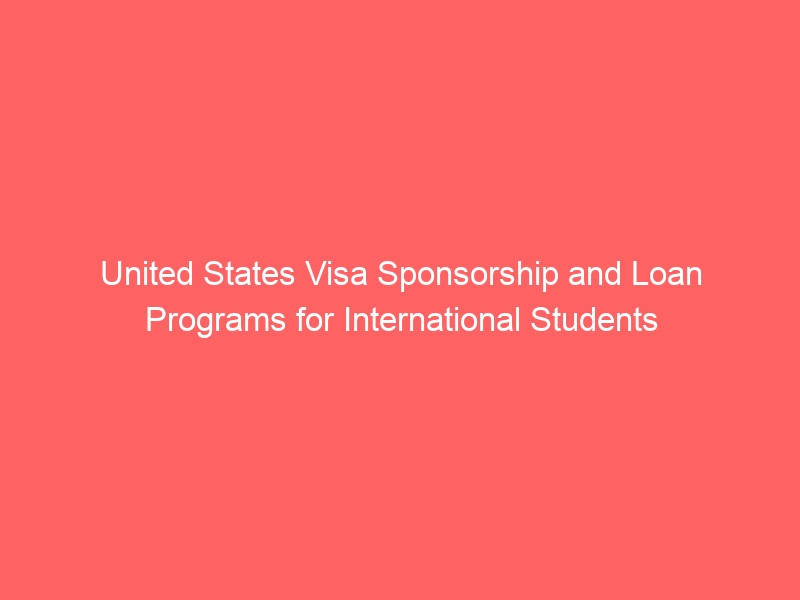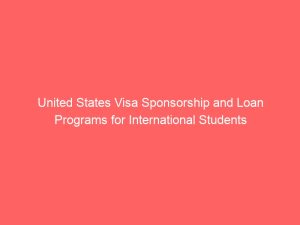The United States has long been a top destination for international students seeking quality education and career opportunities. However, studying in the US can be financially challenging due to high tuition fees, living costs, and other expenses. Many students explore ways to secure funding, including loans and visa sponsorship programs, to make their American education dream possible. Understanding how these systems work, the types of loans available, and how visa sponsorship can benefit you is essential for planning a successful academic journey. This guide explores everything you need to know about United States visa sponsorship and loan programs for international students.
Understanding Visa Sponsorship for International Students
Visa sponsorship refers to a situation where a school, organization, or employer supports a foreign national’s application for a visa to study or work in the US. For students, the most common visas are the F-1 student visa, the J-1 exchange visitor visa, and the M-1 vocational visa. Sponsorship typically involves the sponsor providing necessary documents and ensuring that the student meets the requirements for entry and stay in the country. Universities often serve as sponsors for international students by issuing the I-20 form for F-1 visas or the DS-2019 form for J-1 visas. Without a sponsoring institution, obtaining a student visa can be difficult.
Types of Visa Sponsorship for Students
The two main types of visa sponsorship relevant to students are academic sponsorship and work-related sponsorship. Academic sponsorship is provided by educational institutions, covering the period of study and sometimes including financial aid. Work-related sponsorship occurs when a company offers a job to a student either during or after their studies, often transitioning them from a student visa to a work visa such as the H-1B. This form of sponsorship can be valuable for those planning to stay in the US after graduation.
Loan Programs for International Students in the US
International students face unique challenges when seeking loans because most US banks require a US-based co-signer with good credit history. Despite this, there are lenders and programs designed specifically for foreign students. Broadly, loan options fall into three categories: loans with a US co-signer, loans without a co-signer, and loans from the student’s home country for studying abroad. Some private lenders and fintech companies have developed products that cater to students without US co-signers, often using alternative criteria such as future earning potential instead of credit history.
Federal Loans and International Students
Most US federal student loan programs are not available to international students, as they are typically limited to US citizens and permanent residents. However, there are exceptions for certain eligible non-citizens, such as refugees or those granted asylum. Because federal loans are usually inaccessible, international students often turn to private loans or institutional aid from universities.
Private Loan Options with a US Co-Signer
Many private lenders, such as Sallie Mae or Discover Student Loans, offer competitive interest rates for students with a qualified co-signer. A co-signer is typically a relative or close contact living in the US who agrees to be responsible for repaying the loan if the borrower cannot. Having a co-signer significantly improves the chances of loan approval and may lower interest rates. However, not all students have access to someone who can fill this role, which is why loans without co-signers are also important.
Loans Without a US Co-Signer
A growing number of lenders provide loans without requiring a US co-signer. Companies like MPOWER Financing, Prodigy Finance, and Future Finance assess applicants based on academic performance, chosen field of study, and projected future income. These lenders often partner with universities to make their products accessible and may offer flexible repayment terms that begin after graduation. While interest rates for such loans may be higher, they provide vital access to funding for students who otherwise have no options.
University-Based Loan and Aid Programs
Some universities offer their own loan or grant programs for international students. These funds may come from alumni donations, endowments, or partnerships with financial institutions. Aid packages may be need-based or merit-based, rewarding academic excellence or specific talents. While university-based loans may not cover the full cost of attendance, they can supplement other funding sources to make studying in the US more affordable.
Combining Visa Sponsorship with Loan Programs
For international students, the ideal situation is to secure both visa sponsorship and a reliable loan program. The process typically starts with admission to a US institution, which then provides the necessary sponsorship documents for the student visa application. After obtaining the visa, students can focus on arranging financial aid through loans, scholarships, or personal resources. Some universities have partnerships with loan providers, making it easier for admitted students to access funding.
Repayment Considerations
Repaying loans as an international student requires careful planning. Students must consider currency exchange rates if repayment will be made from abroad, as well as potential income levels based on their career plans. Graduates who secure work in the US through Optional Practical Training (OPT) or H-1B sponsorship may find it easier to repay their loans due to higher earnings. It is important to fully understand repayment terms before accepting any loan, including interest rates, grace periods, and penalties for late payments.
Scholarships and Grants as Alternatives to Loans
While loans are a common solution, scholarships and grants should not be overlooked. These forms of aid do not require repayment and can significantly reduce the need for borrowing. Many organizations, both in the US and internationally, offer scholarships for foreign students. Applying early and meeting all eligibility requirements increases the chances of securing this type of funding.
Challenges Faced by International Students
International students pursuing loans and visa sponsorship face several challenges, including complex paperwork, high costs, and strict eligibility criteria. In some cases, limited credit history or lack of a co-signer can delay or prevent loan approval. Additionally, visa rules may restrict work opportunities during study, making it harder to generate income for living expenses. Being aware of these challenges allows students to plan proactively and seek resources in advance.
The Role of Immigration Policies
US immigration policies can influence both visa sponsorship and loan access for international students. Changes in regulations may affect the number of visas available, eligibility for work permits, or the conditions of staying in the country after graduation. Keeping updated with policy changes and seeking guidance from university advisors or immigration lawyers is crucial.
Steps to Secure a Loan and Visa Sponsorship
The process begins with researching universities that not only admit international students but also offer some form of visa sponsorship and financial aid. After securing admission, students should explore all funding options, starting with scholarships and grants before applying for loans. If a loan is needed, compare offers from multiple lenders, paying attention to interest rates, repayment terms, and eligibility requirements. Obtaining a co-signer, if possible, can improve loan terms. Finally, ensure all visa paperwork is completed accurately and submitted on time.
Long-Term Benefits of US Education with Sponsorship and Loans
Graduating from a US institution with visa sponsorship and the support of a loan program can open doors to global career opportunities. International students often build professional networks, gain work experience through internships, and access competitive salaries after graduation. The combination of education and work experience in the US can also improve eligibility for permanent residency or future visa applications.
Conclusion
For international students, the journey to studying in the United States involves more than just academic preparation. Navigating the complexities of visa sponsorship and securing adequate funding through loan programs are essential steps. While challenges exist, the opportunities provided by a US education—combined with strategic financial planning—can lead to long-term career and personal growth. By researching available programs, preparing documents in advance, and exploring both loan and scholarship options, students can make their American education dream a reality.




